Festivities in the Americas
Opening of the Celebration of the 40th Anniversary of the Ramsar Convention in Huatulco, Mexico
The Ramsar Convention’s 40th Anniversary celebration in the Americas kicked off on 31 January 2011 with the opening ceremony of the Wetland Festival in the auditorium of the Universidad del Mar in Huatulco, Mexico. The event was opened by Mr. Modesto Seara, rector of the Universidad del Mar, who welcomed the participants, Mr. Anada Tiega, Secretary General of the Ramsar Convention, who highlighted the importance of wetland conservation and the role of the Convention in its 40-year trajectory, and Mexican National Focal Point Mr. Luis Fueyo MacDonald, commissioner for the Natural Protected Areas, who welcomed the participants and emphasized the relevance of this celebration for Mexico and the region.
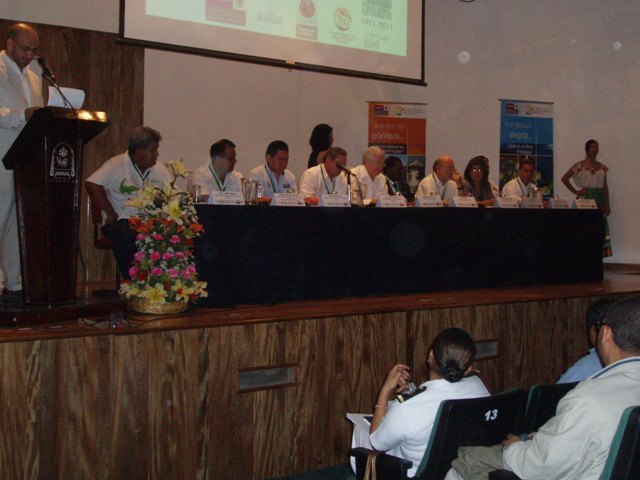 | 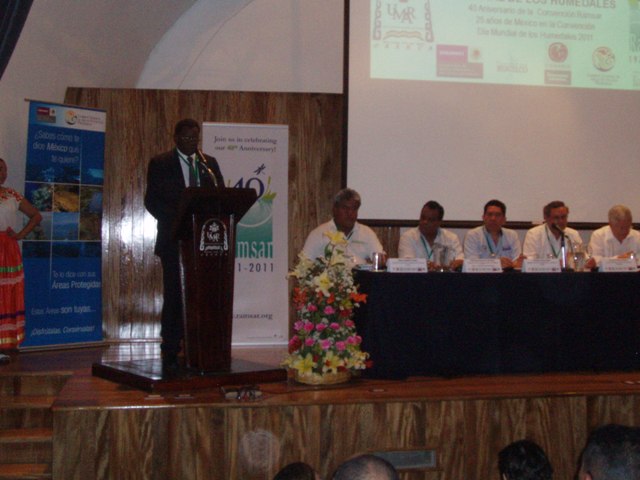 |
Picture 1. Head table during the opening of the wetland festival
Picture 2. Mr. Modesto Seara, Rector (chancellor) of del Mar University
Picture 3. Mr. Anada Tiega, Secretary General of the Ramsar Convention
Some 320 national and international delegates from Ramsar Contracting Parties, non-Contracting Parties, Ramsar International Organization Partners (IOPs), the Scientific and Technical Review Panel (STRP), other multinational environmental agreements, international institutions and networks, academia and the private sector participated in the celebrations. Keynote speeches were made by Mrs. Mara Murillo, UNEP deputy regional director for Latin America and the Caribbean, Mr. José Sarukhán Kerméz from Conabio, Ms. Maria Rivera, Ramsar Senior Advisor for the Americas, and Mr. Luis Fueyo MacDonald, National Commissioner of Protected Areas, who presented the status of the implementation of the Convention in Mexico.
Picture 4. Participants in the celebration
Picture 5. Representatives of Bahamas, Jamaica, Saint Lucia and San Vincent and the Grenadines
The Ramsar Secretariat described the main progress and challenges of the Convention in the Americas and launched the book Wetlands in the Americas: the Role of the Ramsar Convention and the Benefits of the Designation of Ramsar Sites, a new publication that analyzes the present status of the Convention in the Western Hemisphere and illustrates the benefits both of being a member of this international treaty and its community and of designating each country’s wetland treasures as Wetlands of International Importance on the Ramsar List, the largest network of protected areas in the world.
| Ms. Maria Rivera, Senior Advisor for the Americas and Mr. Royal Gardner launching the book Wetlands in the Americas |
Twenty-four presentations were offered in symposia covering such diverse topics as management and wise use of wetlands; private sector involvement in wetland conservation; communication, education and public awareness; participatory approaches to management; and wetlands and climate change. A lively exchange of experiences was made possible on key issues in the Americas region, ranging from wetland inventories and tools for assessing wetland health to legal aspects of wetland conservation, Mexico’s CEPA Strategy, wetland education experiences in the Caribbean, and wetlands and poverty alleviation in Central America, among many others.
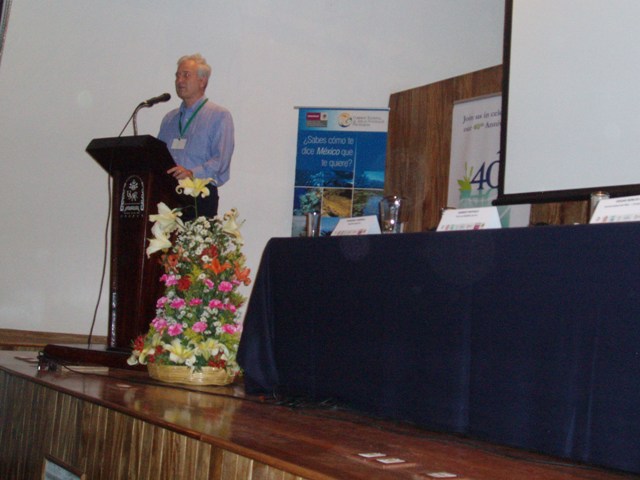 |
Picture 7. Mr. Herb Raffaele from the US Fish and Wildlife Service giving a speech about wetand wise use
Picture 8. Mr. Jairo Valderrama from Colombia talking about the experience “fly a way” funded by the Wetlands for the Future initiative
An evening session was organized to present the 3D docutale “Ondia and the 7 wonders wetland” as well as the high definition movie “Wetlands in Chile”, which shows the role that the private sector plays in the conservation and wise use of wetlands in Chile.
Pictures above: Presentation of the film project Ondia and the 7 wonders
Picture 10. Film Wetlands in Chile
On the 1st of February, the festivities moved to the Explanada, a cultural park in downtown Huatulco, where the participants were welcomed by the Guelaguetza dances from Oaxaca, followed by welcoming remarks from the municipal president of Huatulco, Mr. Lorenzo Lavariega Arista, the inauguration of the stand and posters area, and a playing of the Ramsar game.
Picture 11 Typical Oaxaca dances
Picture 12. Conanp team playing the Ramsar game
Picture 13. Mrs. Maria Rivera, Senior Advisor for the Americas, welcoming the participants and Huatulco local communities
Picture 14. Mr. Lorenzo Lavariega, Municipal President of Huatulco
The evening closed with a gastronomic sampling of typical Oaxacan food offered by the hotels and tourism association of Huatulco. Oaxaca typical food and handicrafts:
On the 2nd of February the celebration of the Ramsar Convention 40th anniversary took place at Punta Arenas beach in the Ramsar Site Cuencas y Corales de la Zona Costera de Huatulco. The ceremony opened with messages from the Ramsar Secretary General, the Mexican subsecretary of environment Mr. Mauricio Limon, and Mr. McDonald, the Ramsar Focal Point, followed by speeches by Omar Vidal from WFF on behalf of Ramsar IOPS, Mr. Bert Lenten, Deputy Secretary General from the CMS Convention on behalf of the CMS and other MEAs, and Mr. Herb Raffaele from the US Fish and Wildlife Service.
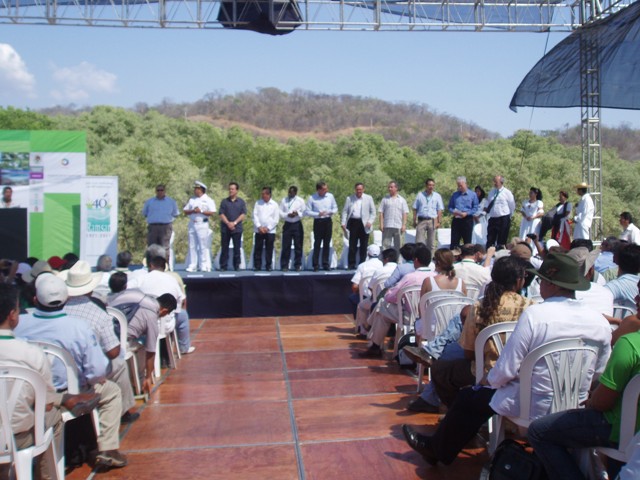 | |
Picture 16. Participants in the event on the 2nd of February
Picture 17. Head table for the celebration
Picture 18. Mr. Luis Fueyo, Mexico Ramsar Focal Point
Picture 19. Mr. Bert Lenten, Deputy Secretary General from CMS
Afterwards, the Ramsar Senior Advisor for the Americas presented the awards to the winners of the competition of schools and Ramsar Sites promoting the wise use of wetlands in the Americas. In the category of schools, the first place was given to Tantramar Regional High School in New Brunswick, Canada, and the second place to East Elgin Secondary School in Aylmer, Ontario, Canada. In the category of Ramsar Sites, Mamiraua Ramsar site was selected for first place and the personnel of Laguna Conchali in Chile received the second place for their efforts for the conservation and wise use of wetlands.
Additionally, Ramsar Site designation certificates were given to authorities from Dominican Republic, El Salvador, Mexico, and the United States.
| Ramsar Sites certificates being received by Enrique Barraza from El Salvador, Lourdes Suarez from Mexico, Herb Raffaele from the United States, and Mateo Felix from the Dominican Republic |
The ceremony was brought to a close by the governor of the State of Oaxaca, Mr. Gabino Cué Monteagudo, who highlighted the importance of this occasion for Huatulco.
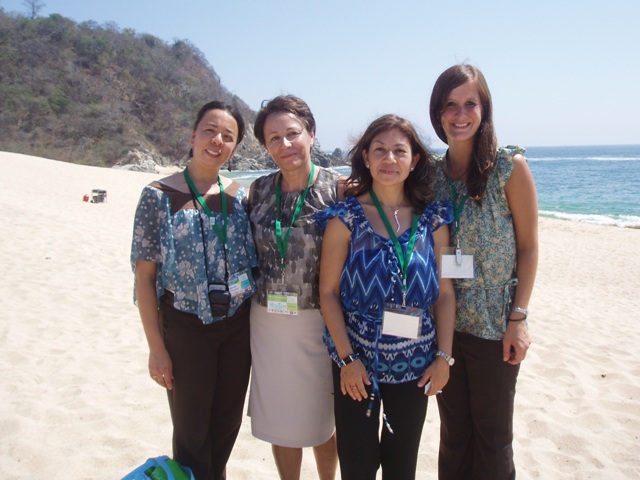 |
Picture 21. Participants in Punta Arenas beach during the celebration
Picture 22. Americas Ramsar team
The wetland festival came to a lively end with a biodiversity parade in Huatulco Explanada that was prepared by schools to call the attention to the necessity of caring for wetlands and their resources.
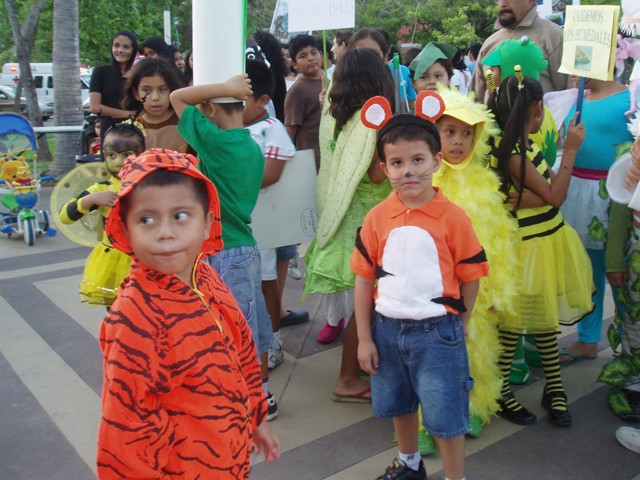 |
| "Biodiversity parade" prepared by Huatulco schools |
The 40 Anniversary celebrations in Huatulco called upon the collaborative efforts of different partners of the Ramsar family, including Semarnat as Ramsar Administrative Authority and the National Commission for National Protected Areas-Conanp (the Ramsar Focal Point), as well as the involvement of Huatulco and other six municipalities, the association of hotels, tourist guides and schools, and the federal and local agencies and Mexican wetland specialists.
At the international level, the participation of Ramsar Focal Points, non-Contracting Parties, STRP members, representatives of international organizations and conventions, and invited panelists made the exchange of experiences especially fruitful and highlighted the major challenges in wetland conservation in the Americas. Overall, the event contributed a great deal to raising awareness about the Ramsar Convention in the Americas at different levels but, what is more important, it demonstrated that the key to success in wetland conservation is to be found in the collaborative work of partners sharing these common objectives.
Report by Maria Rivera